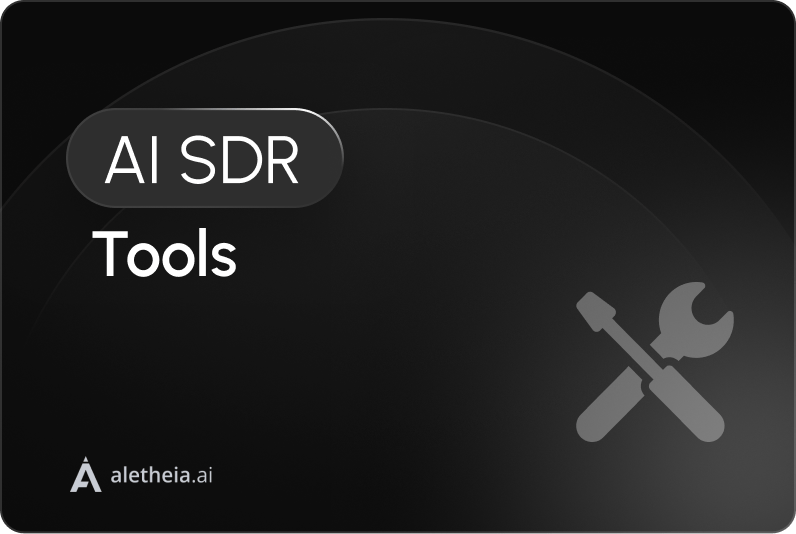
Alethea AI

September 30, 2025

What this guide covers
- What an “AI SDR” actually is (and isn’t)
- How to choose tools (deliverability, research, personalization, safety)
- 18 tools by function (research, enrichment, sequencing, deliverability, governance) with features · pros · cons
- The 4R outreach workflow + implementation steps
- FAQs and metrics to track
What is an AI SDR?
An AI-assisted outbound engine that automates research → personalization → sending → reply parsing → routing, without destroying trust or domain reputation. It augments humans; it doesn’t replace judgment.
How to choose (selection criteria)
- Deliverability: warm-ups, reputation monitoring, automatic throttling.
- Research depth: company + contact + trigger signals in one brief.
- Personalization safety: no hallucinated claims; templated proof points.
- Sequencing control: multi-channel (email + LI + phone) with stop rules.
- Compliance & audit: opt-outs, suppression, approval queue for early sends.
- CRM fit: native HubSpot/SFDC sync with reply intent and meeting routing.
The 18-tool stack (representative, by function)
- A. Research & Enrichmen
- Clay — flexible enrichment and trigger detection. Pros: powerful transforms; wide integrations. Cons: learning curve.
- Apollo — data + sequencing in one. Pros: huge database; fast to start. Cons: data freshness varies.
- ZoomInfo / Cognism — enterprise-grade B2B data. Pros: coverage; intent signals. Cons: cost, contracts.
- B. Personalization & Drafting
- OpenAI/Anthropic (custom prompts) — 90-second briefs and first-line generation. Pros: flexible; can encode your tone. Cons: must guardrail outputs.
- Lavender — tone, clarity, and personalization scoring. Pros: coaching at scale. Cons: best for email only
- C. Sequencing & Sending
- HubSpot Sequences or Salesloft or Outreach — enterprise cadence tools. Pros: governance + analytics. Cons: heavier admin.
- Instantly / Smartlead / Lemlist — high-velocity cold email tools. Pros: fast, affordable. Cons: require strict deliverability ops.
- Gmail + Superhuman — rep-level speed for manual touches. Pros: responsiveness. Cons: not a sequencer.
- D. Deliverability & Reputation
- Mailwarm / Warmup Inbox — ramp sending without flags. Pros: protects domain early. Cons: not a magic bullet.
- Postmaster Tools (Google), Postmark, Mailgun — monitoring + infra. Pros: visibility into issues. Cons: admin needed.
- E. Reply Parsing, Routing & Meetings
- Clay / Zapier / n8n
classify replies, auto-route to AE, update CRM. - Calendly / Cal.com
direct handoff automation. - Gong / Grain
capture first call for enablement.
- Clay / Zapier / n8n
- F. Governance & Compliance
- HubSpot/SFDC governance — approval queue for first 100 sends/user.
- OneTrust / Transcend — privacy, consent, deletion workflows.
- Pixel tracking controls — respect privacy; improve trust.
- Bouncer / NeverBounce — email validation to reduce bounces.
- DMARC/SPF/DKIM — essential records (work with IT).
The 4R outreach workflow (Operator standard)
- Research: auto-generate a 90-second account brief.
- Relevance: one-line observation only you could know.
- Reason: time-bound trigger; why now.
- Request: ask for a 12-minute huddle; offer two time windows.
Safety rails: no claims you can’t cite; stop sending on any positive or objection; approval for early sends; immediate suppression on opt-outs.
Implementation steps (2 weeks)
- Week 1 — domain/auth setup; tool wiring; 20 account test; manual review.
- Week 2 — sequences live; reply parser routes meetings; daily QA; add one LI + one phone step for high-fit accounts.
Metrics / proof hooks
Reply rate (unique, human) · positive intent rate · meetings scheduled · SAL→SQL · domain reputation
FAQs
Will AI kill authenticity?
No—poor prompts + no guardrails do. Encode your voice, keep it specific, and cite truth.



